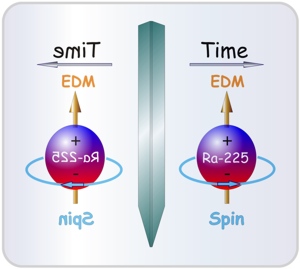Electric Dipole Moment of 225Ra
Time-reversal symmetry
Physical laws were at first thought to be identical under CP-reversal, T-reversal, and CPT-reversal. Here CP-reversal exchanges all the particles involved with their anti-particle partners, T-reversal reverses the direction of time, and CPT-reversal is the combination of CP-reversal and T-reversal. In 1964, however, CP-symmetry was found to be slightly violated in the neutral kaon system by Christenson et al.1 Since then, the CP-symmetry has been the focus of intense research effort and remains today one of the most fundamental issues in physics. Indeed the violation of CP-symmetry is responsible for the fact that the Universe is dominated by matter over anti-matter. Assuming CPT-symmetry holds -- and all experiments so far support this assumption -- the violation of CP-symmetry then implies the violation of T-symmetry. Recently, the KTeV collaboration at Fermi Lab has studied the neutral kaon system with much improved sensitivity and observed more direct evidence that suggests the violation of T-symmetry.2 Meanwhile, two on-going large experimental groups, the BaBar collaboration3 (~ 600 people) at SLAC and the Belle collaboration at KEK have recently observed similar CP-violation effects in the neutral B-meson system. These observed CP-violation effects are consistent with the Standard Model.4
|
|
Figure 1. Under T-reversal, the spin direction reverses while the
EDM direction remains the same, thus a particle that possesses both an
EDM and a spin is converted into a different kind of particle, and
T-symmetry is violated. |
Atomic electric-dipole moment
In parallel with the effort in the high-energy physics field, there has been extensive effort in the search of new types of CP-violation or T-violation effects in low-energy phenomena, where the search of an atomic electric-dipole moment (EDM) has achieved the greatest sensitivity. So far all searches have generated null results.5 An observation of a non-zero EDM would present direct evidence of T-violation (Fig. 1), and help understand the mechanism that causes such violations. The observed CP-violation effects in both the kaon and B-meson systems are too small to explain the observed matter-antimatter asymmetry in the Universe. This leads to the hypothesis that there are sources of CP-violation besides those known in the Standard Model. Extensions to the Standard Model such as Supersymmetry (SUSY), Multi-Higgs models, and Left-Right (L-R) Symmetric models all predict a relatively large EDM that would be accessible with the next generation of EDM-search experiments.6 Therefore, the EDM provides an outstanding opportunity to search for new physics beyond the Standard Model.
225Ra - an attractive case
225Ra is an especially good case for the search of the EDM because it has a relatively long lifetime (t1/2 = 15 d), and has spin 1/2 which eliminates systematic effects due to electric quadrupole coupling. Moreover, its nuclear octupole deformation enhances the atomic EDM by increasing the Schiff moment collectively and by the parity doubling of the energy levels.7,8 For example, the sensitivity to T-odd, P-odd effects in 225Ra is expected to be 2-3 orders of magnitude larger than in 199Hg, which has been used by previous searches to set the lowest limit (< 3 x 10-29 e-cm)5 so far on the atomic EDM.
Laser trapping and cooling radium atoms
We have recently demonstrated laser trapping and cooling of 225Ra atoms9 with the scheme illustrated in Fig. 2. The laser trap allows us to collect 225Ra atoms that are otherwise too rare to be used for the search with the conventional atomic-beam or vapor-cell type methods. Moreover, an EDM measurement on atoms in a laser trap would benefit from the advantages of high electric field, long coherence time, and a negligible so-called "v x E" systematic effect.

Figure 2. Atomic energy diagram of radium. The MOT uses 7s2 1S0 - 7p 3P1 as the primary trapping transition and 6d 3D1 - 7p 1P1 as the repump transition. Room-temperature blackbody radiation was found to serve as an important source to repump atoms at 7p 3P0 - 6d 3D1.
In the next phase of the experiment (Fig. 3), the cold 225Ra atoms will be transferred from the MOT to an optical dipole trap, moved to a neighboring EDM-probing region, and their spin-precession frequency will be measured. The change of the precession frequency upon reversal of the electric field presents the signature of an EDM.

Figure 3. Schematic of the EDM setup.
References
1. J. H. Christensen et al., PRL 13 (1964) 138.
2. A. Alavi-Harati et al. (KTeV Collaboration),
PRL 83 (1999) 22.
3. S. Prell for the BaBar Collaboration, hep-ex/0112013.
4. S. M. Barr, Int. J. Mod. Phys. A8 (1993) 209.
5. E. D. Commins et al., PRA50 (1994); P. G. Harris et al.,
PRL 82 (1999). W.C. Griffith et al., PRL 102 (2009).
6. I. B. Khriplovich & S. K. Lamoreaux, CP Violation without
Strangeness (Springer, 1997).
7. V. Spevak, N. Auerbach, and V. Flambaum, PRC 56 (1997) 1357.
V. A. Dzuba et al., PRA 61 (2000) 062509
8. J. Engel et al., PRC 61,
035502 (2000); PRC 68,
025501 (2003); PRL 94,
232502 (2005)
9. J.R. Guest et al., PRL 98, 093001 (2007)
10. R.H. Parker et al., PRC 86, 065503 (2012)
11. R.H. Parker et al., PRL 114, 233002 (2015)
![[Argonne Logo]](/images/argonne_header_logo.jpg)
![[DOE Logo]](/images/header_doe.gif)
